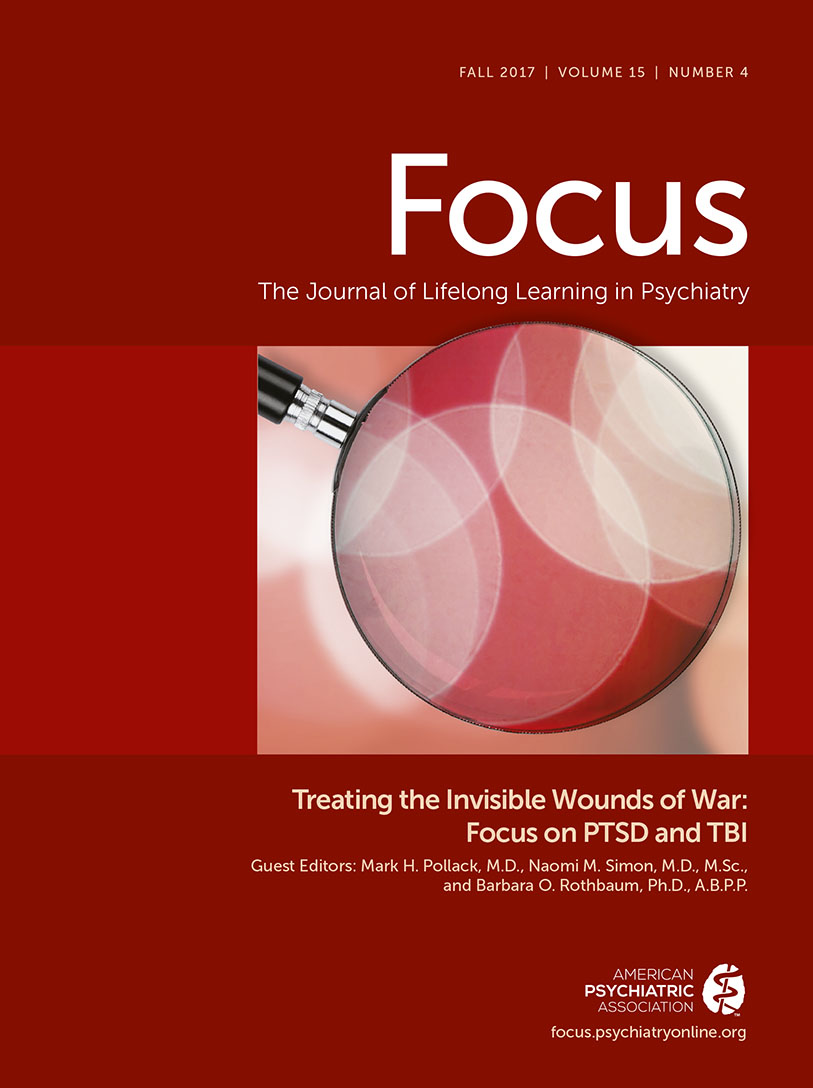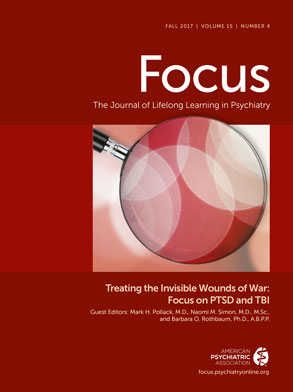PTSD Psychotherapy Outcome Predicted by Brain Activation During Emotional Reactivity and Regulation
Fonzo GA, Goodkind MS, Oathes DJ, et al.
Am J Psychiatry 2017 (Epub ahead of print, July 18; doi: appiajp201716091072)
Objective: Exposure therapy is an effective treatment for posttraumatic stress disorder (PTSD), but many patients do not respond. Brain functions governing treatment outcome are not well characterized. The authors examined brain systems relevant to emotional reactivity and regulation, constructs that are thought to be central to PTSD and exposure therapy effects, to identify the functional traits of individuals most likely to benefit from treatment. Method: Individuals with PTSD underwent functional MRI (fMRI) while completing three tasks assessing emotional reactivity and regulation. Participants were then randomly assigned to immediate prolonged exposure treatment (N=36) or a waiting list condition (N=30). A random subset of the prolonged exposure group (N=17) underwent single pulse transcranial magnetic stimulation (TMS) concurrent with fMRI to examine whether predictive activation patterns reflect causal influence within circuits. Linear mixed-effects modeling in line with the intent-to-treat principle was used to examine how baseline brain function moderated the effect of treatment on PTSD symptoms. Results: At baseline, individuals with larger treatment-related symptom reductions (compared with the waiting list condition) demonstrated 1) greater dorsal prefrontal activation and 2) less left amygdala activation, both during emotion reactivity; 3) better inhibition of the left amygdala induced by single TMS pulses to the right dorsolateral prefrontal cortex; and 4) greater ventromedial prefrontal/ventral striatal activation during emotional conflict regulation. Reappraisal-related activation was not a significant moderator of the treatment effect. Conclusions: Capacity to benefit from prolonged exposure in PTSD is gated by the degree to which prefrontal resources are spontaneously engaged when superficially processing threat and adaptively mitigating emotional interference, but not when deliberately reducing negative emotionality.
Prevention of Trauma and Stressor-Related Disorders: A Review
Howlett JR, Stein MB
Neuropsychopharmacology 2016; 41:357–369
Posttraumatic stress disorder (PTSD) is a common, frequently chronic, and disabling condition which, along with acute stress disorder (ASD), is categorized as a trauma- and stressor-related disorder by the DSM-5. These disorders are unique in requiring exposure to a severe stressor, which implies that potential sufferers could be identified and helped before developing a disorder. Research on prevention strategies for stress-related disorders has taken a number of avenues, including intervention before and after trauma and the use of both psychosocial and somatic approaches. Despite advances in neurobiological understanding of response to trauma, clinical evidence for preventive interventions remains sparse. This review provides an overview of prevention approaches and summarizes the existing literature on prevention of ASD and PTSD, including clinical and preclinical studies. Given the potential benefits to trauma survivors and society, the development of effective preventive interventions should be given greater priority. Resources should be directed to adequately test promising interventions in clinical trials, and research should be conducted according to translational research principles in which preclinical research informs the design of clinical studies.
Psychotherapy Versus Pharmacotherapy for Posttraumatic Stress Disorder: Systemic Review and Meta-Analyses to Determine First-Line Treatments
Lee DJ, Schnitzlein CW, Wolf JP, et al.
Depress Anxiety 2016; 33:792–806
BACKGROUND: Current clinical practice guidelines (CPGs) for posttraumatic stress disorder (PTSD) offer contradictory recommendations regarding use of medications or psychotherapy as first-line treatment. Direct head-to-head comparisons are lacking.
METHODS: Systemic review of Medline, EMBASE, PILOTS, Cochrane Central Register of Controlled Trials, PsycINFO, and Global Health Library was conducted without language restrictions. Randomized clinical trials≥8 weeks in duration using structured clinical interview-based outcome measures, active-control conditions (e.g. supportive psychotherapy), and intent-to-treat analysis were selected for analyses. Independent review, data abstraction, and bias assessment were performed using standardized processes. Study outcomes were grouped around conventional follow-up time periods (3, 6, and 9 months). Combined effect sizes were computed using meta-analyses for medication versus control, medication pre/posttreatment, psychotherapy versus control, and psychotherapy pre/posttreatment.
RESULTS: Effect sizes for trauma-focused psychotherapies (TFPs) versus active control conditions were greater than medications versus placebo and other psychotherapies versus active controls. TFPs resulted in greater sustained benefit over time than medications. Sertraline, venlafaxine, and nefazodone outperformed other medications, although potential for methodological biases were high. Improvement following paroxetine and fluoxetine treatment was small. Venlafaxine and stress inoculation training (SIT) demonstrated large initial effects that decreased over time. Bupropion, citalopram, divalproex, mirtazapine, tiagabine, and topiramate failed to differentiate from placebo. Aripiprazole, divalproex, guanfacine, and olanzapine failed to differentiate from placebo when combined with an antidepressant.
CONCLUSIONS: Study findings support use of TFPs over nontrauma-focused psychotherapy or medication as first-line interventions. Second-line interventions include SIT, and potentially sertraline or venlafaxine, rather than entire classes of medication, such as SSRIs. Future revisions of CPGs should prioritize studies that utilize active controls over waitlist or treatment-as-usual conditions. Direct head-to-head trials of TFPs versus sertraline or venlafaxine are needed.
Copyright 2016 Wiley Periodicals, Inc.
Prospective Longitudinal Evaluation of the Effect of Deployment-Acquired Traumatic Brain Injury on Posttraumatic Stress and Related Disorders: Results From the Army Study to Assess Risk and Resilience in Servicemembers (Army STARRS)
Stein M.B., Kessler RC, Heeringa SG, et al.
Am J Psychiatry 2015; 172(11):1101–1111
Objective: Traumatic brain injury (TBI) is increasingly recognized as a risk factor for deleterious mental health and functional outcomes. The purpose of this study was to examine the strength and specificity of the association between deployment-acquired TBI and subsequent posttraumatic stress and related disorders among U.S. Army personnel.
Method: A prospective, longitudinal survey of soldiers in three Brigade Combat Teams was conducted 1–2 months prior to an average 10-month deployment to Afghanistan (T0), upon redeployment to the United States (T1), approximately 3 months later (T2), and approximately 9 months later (T3). Outcomes of interest were 30-day prevalence postdeployment of posttraumatic stress disorder (PTSD), major depressive episode, generalized anxiety disorder, and suicidality, as well as presence and severity of postdeployment PTSD symptoms.
Results: Complete information was available for 4,645 soldiers. Approximately one in five soldiers reported exposure to mild (18.0%) or more-than-mild (1.2%) TBI(s) during the index deployment. Even after adjusting for other risk factors (e.g. predeployment mental health status, severity of deployment stress, prior TBI history), deployment-acquired TBI was associated with elevated adjusted odds of PTSD and generalized anxiety disorder at T2 and T3 and of major depressive episode at T2. Suicidality risk at T2 appeared similarly elevated, but this association did not reach statistical significance.
Conclusions: The findings highlight the importance of surveillance efforts to identify soldiers who have sustained TBIs and are therefore at risk for an array of postdeployment adverse mental health outcomes, including but not limited to PTSD. The mechanism(s) accounting for these associations need to be elucidated to inform development of effective preventive and early intervention programs.
Treating Veterans and Military Families: Evidence Based Practices and Training Needs Among Community Clinicians
Richards LK, Bui E, Charney M, et al.
Community Mental Health Journal 2016; 53:215–223
Little is known about the capacity of community providers to provide military informed evidence based services for posttraumatic stress disorder (PTSD). We conducted a regional, web-based survey of 352 community mental health care providers that sought to identify clinical practices, training needs, and predictors of evidence based treatment (EBT) use for PTSD. Overall, 49 % of providers indicated they seldom or never use a validated PTSD screening instrument. Familiarity with EBTs, specifically prolonged exposure (PE; χ2 (4) = 14.68, p < .01) and cognitive processing therapy (CPT; χ2(4) = 4.55, p < .05), differed by provider type. Of providers who received training in PE or CPT (N = 121), 75 % reported using treatment in their practice, which was associated with having received clinical supervision (χ2(1) = 20.16, p < .001). Widely disseminated trainings in empirically supported PTSD assessment and treatment, and implementation of case supervision in community settings are needed.
Reprinted with permission from Springer Science.

